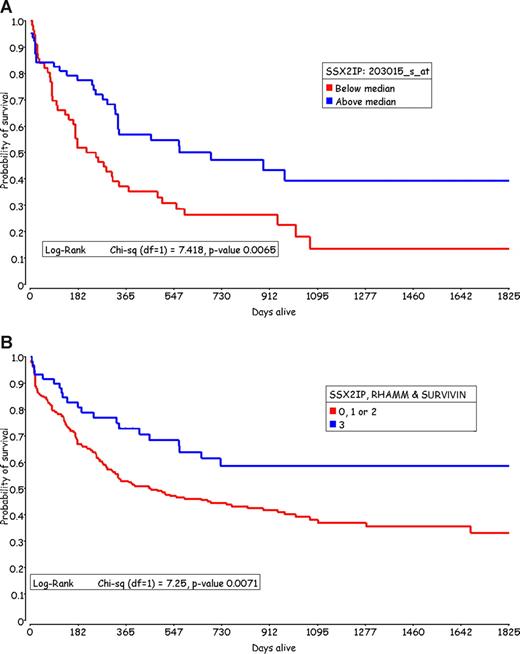To the editor
Greiner et al1 described a positive association between elevated leukemia-associated antigen (LAA) expression (RHAMM, G250/CA9, and PRAME) and survival in 116 acute myeloid leukemia (AML) patients by microarray. We have analyzed 312 presentation AML samples using 199 133A chips and 113 Plus2 chips and segregated AML patients based on above- and below-median levels of expression of the LAA synovial sarcoma X breakpoint 2–interacting protein (SSX2IP).2-4 Analysis of Kaplan-Meier curves showed an association between elevated SSX2IP expression and improved survival times (log-rank test, P = .05). We found that SSX2IP expression did not predict the survival of AML patients who had detectable cytogenetic abnormalities; however, it was significantly associated with improved survival rates in patients with no detectable cytogenetic rearrangements (log-rank test, n = 180; P = .007; Figure 1A). We also found a correlation between elevated SSX2IP expression and other clinical parameters that are considered to be good prognostic markers: days in remission (log-rank test, P = .03), age at diagnosis (< 60 years; t test, P = .003), and FLT3 WT (t test, P = .004).
SSX2IP expression indicates survival rates in AML patients who lack cytogenetic abnormalities. (A) In patients with a normal karyotype, elevated SSX2IP was associated with significantly improved survival rates (log-rank test, P = .007). (B) The expression of all 3 (RHAMM, Survivin, and SSX2IP) LAAs above the median was associated with significantly extended survival times in patients with a normal karyotype, compared with having elevated expression of 2 or fewer of these LAAs (0, 1, or 2; log-rank test, P = .021). The x-axis shows days alive over a 5-year follow-up period and the y-axis indicates probability of survival.
SSX2IP expression indicates survival rates in AML patients who lack cytogenetic abnormalities. (A) In patients with a normal karyotype, elevated SSX2IP was associated with significantly improved survival rates (log-rank test, P = .007). (B) The expression of all 3 (RHAMM, Survivin, and SSX2IP) LAAs above the median was associated with significantly extended survival times in patients with a normal karyotype, compared with having elevated expression of 2 or fewer of these LAAs (0, 1, or 2; log-rank test, P = .021). The x-axis shows days alive over a 5-year follow-up period and the y-axis indicates probability of survival.
When we examined SSX2IP together with the expression of other LAAs known to be associated with improved survival (reviewed in Greiner et al5 ) we found a significant correlation with SURVIVIN (Pearson correlation, P = 3.97 × 10−5) and RHAMM (Pearson correlation, P = 4.3 × 10−5). Greiner et al1 suggested that the expression of distinct LAAs on leukemic blasts may lead to the eradication of residual disease after intensive chemotherapy. RHAMM and Survivin, like SSX2IP, have increased expression in proliferating cells,6,7 while RHAMM and SSX2IP are both expressed on the surface of malignant cells.7 There appears to be a small but growing group of LAAs that are coexpressed in AML patients and are associated with improved survival (our results here and Greiner et al1 ). We examined whether having 1 or more of SSX2IP, Survivin, or RHAMM affected survival in patients with a normal karyotype and found that having expression of none, 1, 2, or all 3 of these LAAs was a significant prognostic indicator (log-rank test, P = .021, respectively; Figure 1B). With regard to the presence of cytogenetic abnormalities, these appear to supersede the influence of elevated LAA expression on prognosis.
In summary, we have found that SSX2IP expression at disease presentation predicts good survival in AML patients with no detectable cytogenetic rearrangements. This may, in part, explain why patients with low LAA expression (often the elderly) fail to elicit effective immune responses and tend to have poorer survival. A new phase in cancer-targeted therapy will be particularly difficult, but especially needed, for AML patients whose tumors lack cytogenetic abnormalities and detectable immunogenic LAA expression and whose survival rates are notably reduced.
Authorship
This work was funded by Leukemia Research (London, United Kingdom; B.G.), the German José Carreras Leukemia Foundation (DJCLS RO5/22; München, Germany; J.G.) and the German Research Fund (DFG, GR2676/1-1; Bonn, Germany). The MRC clinical trials and associated microarray studies are funded by the Medical Research Council (London, United Kingdom).
Correspondence: Dr Barbara Guinn, Department of Haematological Medicine, King's College London School of Medicine, The Rayne Institute, 123 Coldharbour Lane, London, SE5 9NU, United Kingdom; e.mail: barbara.guinn@kcl.ac.uk.
References
Author notes
*B.G. and J.G. are considered joint first authors.


This feature is available to Subscribers Only
Sign In or Create an Account Close Modal